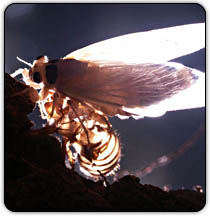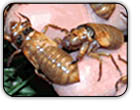
|
|
Light shines beneath a winged
adult cicada and its discarded shell.
Photograph by Roger P. Hangarter
| | | Cicada Invasion: Award-Winning Film Records Astonishing
Bugs
By Catherine Clarke Fox
National Geographic Kids News
November 10, 2005
The bugs pour out of the ground like a bubbling
spring alive with energy, millions and millions of them clawing up
through the dirt in the darkness of night. Sound like a science
fiction movie?
Actually the amazing film Return of the
17-Year Cicadas shows the life cycle of cool insects that spend
most of their lives underground, emerging every 17 years to mate and
create a new generation over a few weeks.
 |
|
Young cicadas crawl on a man's
fingertips.
Photograph by Keith Clay
| | |
The film won first prize in a competition
sponsored by the National Science Foundation and Science
magazine.
There are 12 groups of these 17-year cicadas
(including the species Magicicada Septendecim, M.
cassini, and M. septendecula), and in 2004 it was time
for group number ten (Brood X—"X" is "ten" in Roman numerals) to
come out into the world.
Trillions of them, living all those years in the
soil and feeding on sap from tree roots, dug tunnels and came up
through the earth, covering everything from trees to sidewalks. The
largest numbers appeared in southern Indiana, southern Ohio,
Washington, D.C., and Pennsylvania.
Two men decided to make a movie to share this
extraordinary biological happening with people across the world.
"Every day there was something new," said Roger Hangarter, one of
the film's producers and a plant biologist at Indiana University in
Bloomington.
Hangarter and university student Samuel Orr
filmed the movie mostly in Hangarter's backyard.
"They came out of the ground every night for two
weeks. My wife thought the yard was going to cave in!" Hangarter
said.
Using time-lapse photography to take a picture
every few seconds, the producers were able to show in a few minutes
what took them hours to observe: The cicadas came out of the ground
in their young form, known as the nymph form, and transformed by
sunrise into winged adults.
In the summer of 2004, people living with the
cicada invasion were fascinated by the short-term visitors. They
talked about them, listened to the roar of their songs, and even ate them.
Hangarter spent many weeks observing and filming
his subjects with Orr, but he was never tempted to munch on members
of his project: "I heard there were even cookies made with cicadas,"
he said. "But no, I never tried one!"
If he changes his mind about tasting this group,
he'll just have to wait another 17 years.
See the video Return of the 17-Year Cicadas. It may take
several minutes to load.
Fast Facts
• Periodical cicadas get their names because
they come out of the ground periodically, some on a two-year
schedule and others after longer periods of time.
• Scientists think the cicadas seem to all come
out at the same time because they wait for the soil and air to warm
to 64°F (18°C) as summer comes.
• These bugs are big: Most measure 1 to 2 inches
(25 to 50 millimeters).
• About one and a half hours pass from the time
the cicada's hard shell cracks open to when its wings emerge.
• No one knows why the cicada's life cycle is 17
years, but some people suggest that because many cicadas emerge only
after a long while instead of only a few each year, predators can't
gobble them all up and kill off the species.
| 

